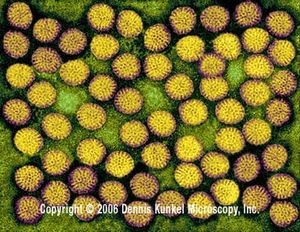Reoviridae
A Viral Biorealm page on the family Reoviridae

Baltimore Classification
Higher order taxa
Viruses; dsRNA viruses; Reoviridae
Genera
Orthoreovirus, Rotavirus, Orbivirus, Coltivirus, Aquareovirus, Seadornavirus, Cypovirus, Idnoreovirus, Fijivirus, Phytoreovirus, Oryzavirus, Mycoreovirus
Description and Significance
Reoviruses, or Respiratory Enteric Orphan viruses, infect invertebrates, vertebrates, and plants. In vertebrates, reoviruses cause infections of the respiratory and gastrointestinal tracts. Rotaviruses, part of the Reovirus family, are a major cause of infant deaths in the developing world, killing over 800,000 children under the age of 2 each year. Originally, reoviruses were classified as echoviruses, in the family Picornaviridae. (source: Wong)
Genome Structure
The reovirus genome is monomeric and consists of ten to twelve segments (depending on the genus) of linear, double-stranded RNA. The complete genome is 18200-30500 nucleotides long. There is a methylated nucleotide cap on the 5'-terminus. Each virion contains a full-length copy of the genome. (source: ICTVdB)
Virion Structure of a Reovirus
Reovirus virions are non-enveloped and consist of a capsid, a core, and a nucleoprotein complex. The capsid is 60-80 nm in diameter and is icosahedral. The virion has a double protein shell. Virus particles can be in inclusion bodies that are not occluded and contain one nucleocapsid, or they can be occluded by protein bodies. (source: ICTVdB)
Reproduction Cycle of a Reovirus in a Host Cell
There are three highly interesting and characteristic features regarding the replication of reoviruses. They are dsRNA viruses which replicate in the cytoplasm, indicating they have everything they need for replication and do not utilize the cell's replication enzymes. They do not fully uncoat during the process of replication because the coat is resistant to protease digestion, preventing them from being completely destroyed by the infected cell. The mRNA used in translation is synthesized from the negative strand of the dsRNA. Each negative strand produces many positive strands. Particle-associated transcriptase is involved in the process. Neither of the strands of dsRNA appear among the transcription products, and both strands remain in the uncoated core particle. The capped positive strand of RNA found in progeny dsRNA is synthesized from the negative strand template found in the dsRNA within the parental cores. These capped transcripts that result from primary transcription are not polyadenylated. Secondary transcription occurs in the later stage of infection and results in uncapped non-polyadenylated transcripts. mRNAs leave the core and get translated in the cytoplasm. The segmented genome allows for possible reassortment, something that has yet to be seen naturally but can be made to occur in vitro.
There are several diferences in the modes of entry into and exit from cells between the different genera in the Reoviridae family. Orthoreoviruses are the most extensively studied virus of the family.
Only certain genes are transcribed initially in replication. The other genes are transcribed after the synthesis of the early viral protein. The virions are released by cell lysis after they have been self-asembled and have accumulated in the inclusion bodies in the cytoplasm of the cell.
(sources: Bernstein,
Viral Ecology & Pathology
Reoviruses infect a wide variety of organisms through equally varied vectors. For more information, see Orthoreovirus and Rotavirus.
References
Bernstein, Caryn. Humans and Viruses: Reovirus.
ICTVdB - The Universal Virus Database, version 4. http://www.ncbi.nlm.nih.gov/ICTVdb/ICTVdB/
